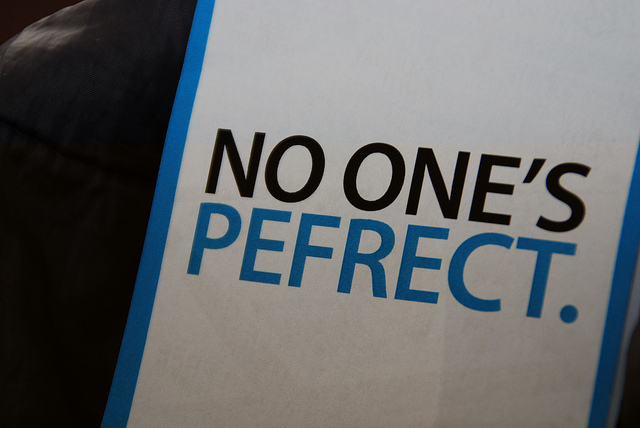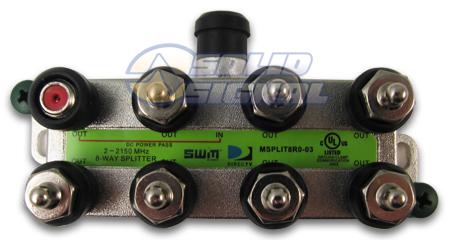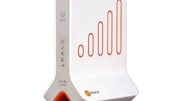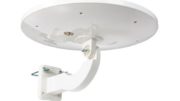This isn’t a rumor. Using any garden-variety 8-way splitter to distribute signal will mean that the output signal is only about 3.6% as strong as the input signal. Just that fact alone should make you think twice about using an 8-way splitter if you don’t have to.
Let’s dig deep into this and get the answers.

The first thing you need to realize is that using a signal literally splits the signal. It’s like, if you have a pie, and you cut that pie into slices, each person only gets a small amount of pie. They don’t get the whole pie. If you cut the pie into 8 slices, each person gets 1/8th of the pie. That makes sense right?
So if you are cutting a signal into 8 pieces — that’s what you’re doing when you’re using a splitter — each person gets an eighth. Since another way of saying “1/8th” is “12.5%”, you can see that right there, each output signal is only 12.5% as strong as the input signal. Another way of saying that is, the output signal loses 87.5% of is strength. (100% – 12.5% = 87.5%. I know, I didn’t say there would be math in this article.
So you lose 87.5%. The title says you lose 96%. Where’s the rest of it?

Nothing in life is perfect. In a perfect scenario you would lose only 87.5%, but there’s a lot going on in a splitter. First of all you have two connectors. Each one is responsible for up to 5% extra loss, because signal always loses strength when it goes through a connection point. This is called insertion loss and it’s one of those things you have to count on in life as a commercial installer, sort of life death and taxes.
There’s also a small amount of loss from the other components in the splitter. Together, all of these amount to the extra roughly 8-9% of signal that’s lost.
This is a case where, if you think about it, you can see where a cheap splitter could be a real problem. If you are guaranteed to lose 87.5% of the signal just by splitting it, imagine if poor quality components accounted for another 12% of loss! It’s very possible using a cheap splitter that you would end up with an unusable signal.
So yeah, you lose 96%. What does it mean?
The good news is that losing 96% of the signal strength isn’t as devastating as it sounds. There’s a reason we measure signals in dBm instead of in volts or watts. RF signals are basically little bits of electricity, so you could measure them the same way you measure the current from an outlet or the power used by a light bulb. However, signal is different from current.
When you think of electrical current, it sometimes helps to think about it like water. You have a certain amount of it, it flows at a certain speed, and it comes out at a certain pressure. And, no matter if it’s clean or dirty, whether it’s clear or cloudy, one thing is certain: if water hits you, you’ll get wet.
Signal is more like words on a page. Those words can be really really big or really really small, but they mean the same thing no matter what size they are. The only time you care is when they are so big they fall off the page (with signal we call this ‘clipping’) and when they are so small that you can’t read them (we call this ‘signal loss.)
So making a word 96% smaller doesn’t mean that you can’t read it, most of the time. The same is true with signal. Losing 96% of your signal sounds tragic but it usually isn’t.
That’s why we tend to measure signal in dBm. dBm is a measurement of how much signal you have relative to a thousandth of a watt. Positive numbers mean you have more than one milliwatt, while negative numbers mean you have less. The most important thing about dBm is that the numbers are logarithmic.
Scary word, logarithmic. But it’s not that bad.
How signal really gets measured.
A typical splitter will cause a loss of 14dB. That equates out to 96% loss. 3dB means you lose half the signal, 10dB means you lose 90% of the signal, 20dB means you lose 99% of the signal. There’s a whole translation thing but what you really need to know here is that we measure in dB (or decibels) not actual signal.
A loss of 3dB means you’ve lost 50% of the signal but because it’s signal not current, you don’t care a lot. Losing 14dB is a lot but it’s not tragic. You can add an amplifier to make up for that loss which is like taking a tiny word and blowing it up on a copier.
So bottom line yes an 8-way splitter cuts the signal significantly. It’s not as bad as it seems, though, and as long as you manage the loss by adding amplifiers when that’s possible, you’ll be ok.





